The Purple Sunbird is a tiny, dazzling marvel that flits through gardens, fields, and forests across India. Its electric hues, curved beak, and buzzing energy make it one of the most easily recognizable nectar-feeders in the subcontinent. Often mistaken for a hummingbird due to its hovering skills, this little bird brings a burst of color and life wherever it goes.

Whether you’re a seasoned birdwatcher or just someone who enjoys morning chai in the garden, the Purple Sunbird is a delightful visitor worth knowing and loved by all Nature Storytellers.
Appearance of Purple Sunbirds – Nature’s Miniature Showstopper
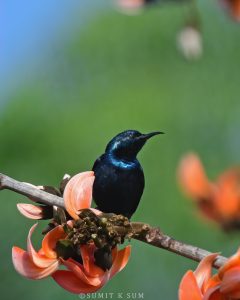
♂ Male (Breeding Plumage) |
| Deep, metallic purple with iridescent blue and black tones |
| Slightly curved, slender beak built for nectar feeding |
| Flash of yellow under the wings when flying |
| Breeding plumage appears most prominently between March and September |
♂ Male (Non-breeding / Eclipse Plumage) |
| Olive brown with dull yellow underparts |
| Dark throat patch and metallic tinges on the head |
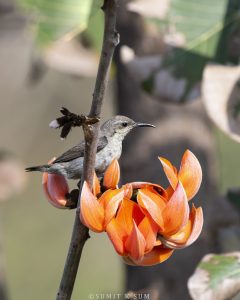
♀ Female |
| Olive-brown above, yellowish below |
| Dark eye-stripe and curved beak similar to the male |
| More subtle, yet just as active and curious |
🪶 Did you know? Males sometimes look like a different bird outside breeding season — a clever way to stay low-profile from predators!
Where Purple Sunbirds Live: From Roofs to Rainforests
The Purple Sunbird is a versatile bird that thrives across India and beyond. Its adaptability is one reason it’s so commonly seen, even in bustling cities.
🌍 Distribution
- Found throughout the Indian subcontinent
- Also seen in Pakistan, Nepal, Bangladesh, and parts of Southeast Asia
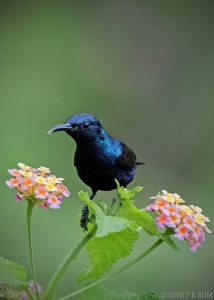
🏡 Habitat
- Home gardens
- City parks and green belts
- Agricultural fields
- Forest clearings and scrublands
- Mangroves and plantations
They prefer areas rich in flowering plants — both native species and ornamentals — making them frequent guests in urban balconies and temple gardens.
Food & Foraging of Purple Sunbirds
The Purple Sunbird feeds primarily on nectar, much like hummingbirds — but they also consume small insects for protein, especially during nesting season.
🌸 Diet of Purple Sunbirds
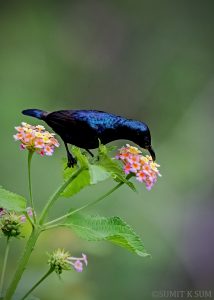
| Nectar from flowers like hibiscus, bottlebrush, trumpet vine, lantana, and more |
| Tiny insects, ants, and spiders |
| Occasionally sips sugar water from feeders |
💡 Feeding Behaviour of Purple Sunbirds
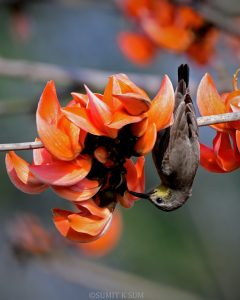
| Hovers briefly while feeding, or clings to stems |
| Uses its long, tubular tongue to lap up nectar |
| Forages alone or in pairs; less often in small groups |
🐝 Bonus Fact: They are excellent pollinators. As they move between flowers, they help plants reproduce — a vital ecological role.
Suggested Read: Common Kingfisher – The River Jewel
Breeding and Nesting in Purple Sunbirds
Breeding season generally starts in March and peaks during the monsoon when flowers and insects are abundant.
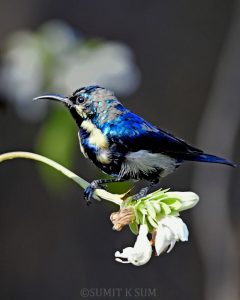
🪺 Nesting Behaviour of Purple Sunbirds
| Builds hanging, pouch-like nests using cobwebs, plant fibers, feathers, cloth, and even plastic |
| Female constructs the nest alone, often taking over a week |
| Nest may be suspended from tree branches, telephone wires, or under roofs and awnings |
🐣 Reproduction in Purple Sunbirds
| Lays 1–3 eggs, usually 2 |
| Female incubates the eggs (around 15 days) |
| Both parents feed the chicks post-hatching |
| Chicks fledge about 2–3 weeks after hatching |
Their nest is a masterpiece of bird engineering — soft, compact, and surprisingly strong.
Sounds & Songs of Purple Sunbirds
Purple Sunbirds aren’t loud, but their presence is often announced by:
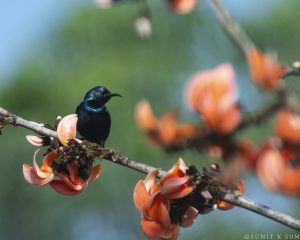
| Short, fast chirps: “tzeet-tzeet” |
| A series of high-pitched trills and squeaky calls |
| Males may sing from perches during breeding season to attract females |
You’re more likely to hear them before you see them — especially when they’re feeding among flowers.
Folklore & Cultural Significance of Purple Sunbirds in India
The Purple Sunbird doesn’t just sparkle in gardens — it shines in stories, beliefs, and traditions too.
📜 Regional Lore
- In Rajasthan, farmers believe that seeing a Purple Sunbird in blooming fields is a sign of good rainfall and a prosperous harvest.
- In Kerala, it’s associated with Vishukkani, where the first sight on New Year’s morning should be auspicious — and sunbirds are considered lucky.
- In Bengali poetry, its presence in gardens is seen as a metaphor for fleeting beauty and silent devotion.
🎨 Artistic Representation
- Mughal-era miniatures sometimes depicted birds like the sunbird among flowering vines, representing love, renewal, and courtship.
- It’s a recurring image in modern Indian nature art and photography, often titled “Jewels of the Garden.”
Also Read: Indian Peafowl – The Pride of India
Why the Purple Sunbird Matters
Beyond its beauty, this bird plays an essential role in nature:
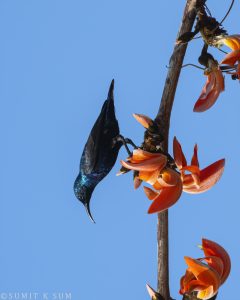
| Pollinator for many native and exotic plant species |
| Insect controller — especially during breeding |
| Indicator species — their presence suggests a healthy flowering ecosystem |
Threats & Conservation Status of Purple Sunbirds
Although the Purple Sunbird is currently listed as Least Concern by IUCN, it faces growing challenges:
| Pesticide exposure in gardens and farms |
| Loss of flowering plants due to urban landscaping trends |
| Plastic waste used in nest building, which can harm chicks |
| Window collisions and predation in cities |
✅ What You Can Do
- Grow native, flowering plants
- Avoid using chemical pesticides
- Offer sugar-water feeders (with care)
- Share your sightings with birding groups to raise awareness
Fun Facts about Purple Sunbirds to Impress Your Friends
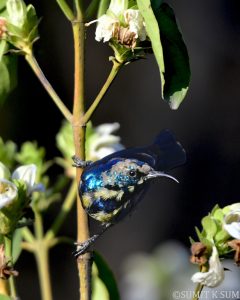
| Not all sunbirds are purple! India hosts several species, including Loten’s and Crimson-backed Sunbirds. |
| Purple Sunbirds are sexually dimorphic — males and females look completely different. |
| Their eggs are white with reddish spots and resemble polished beads. |
| They love hibiscus so much that some garden centers jokingly call it the “sunbird magnet.” |
The Purple Sunbird is one of India’s most charismatic garden birds — bold in color, busy in movement, and bursting with charm. As urban spaces grow and wild spaces shrink, birds like these remind us to keep nature close — and vibrant.
So next time you hear a cheerful chirp near your window or see a tiny flash of purple zip through the flowers, stop and smile. It’s more than a bird — it’s a sign that nature still thrives.
🪶 You May Also Like
- White-throated Kingfisher – The Blue Bolt
- Indian Pitta – The Monsoon Visitor
- Spotted Owlet – The Tiny Night Guardian
| Get your favourite Purple Sunbird photograph framed for your wall – Request Now @+91-9540178459 |
